Lafitte 44
Circa 1982
by David Pascoe
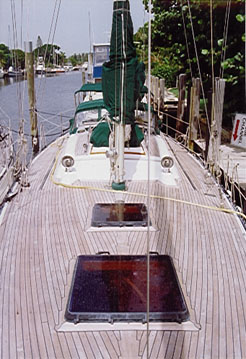
It was with little surprise that I ran across two articles in the Wall Street Journal, and several others in non-marine publications lamenting the state of the sailboat industry. If I remember correctly, it said sailboat production for all of 1997 was barely 2000 boats. Factoring in used boat sales, sailing yachts have now declined to a scant 10% of the boating industry. While there is more than one reason for this, one of the most often cited are the ult light, highly unstable and poor handing craft that are now being produced to imitate racing craft. From boats that have such violent motions that make everybody sick, to tooth pick rigs held in place with wire threads that don't stand up long, are some of the common refrains. The latest WSJ article quoted a middle-aged lady with a lot of sailing under her belt as saying that their last boat (new) just plain made her sick. Literally, that is.
So what does this have to do with the Lafitte 44? Nothing, I just thought it might be interesting to write this review with the state of the sailboat business in mind. If the sail boat business shrinks any further, its going to disappear altogether. Those of you who ask why I don't do more sail reviews, now you know the answer.
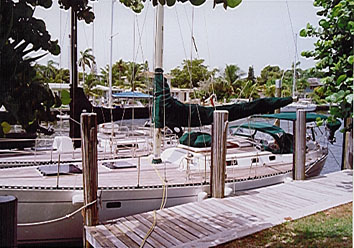
Who is Lafitte and where are they built? I never found out, but some literature indicates that it was formerly Pacific Far East Industries, so I'd guess Taiwan. Production, or should I say import, years are listed as 1981-86, although possibly going back further. Frankly I try to avoid reviewing Taiwan boats because they raise too much dust, but this one is a worthy exception. Like most Taiwan boats, who actually built it is something of a mystery.
This is a static review, since I only got to go over her at dockside, so I have no idea how well she sails, but she reminds me a lot of a Swan 40 I used to sail back in the early 1970's. Not only the way she looks but the way she's built. Sturdy and well. Starting with a canoe stern, a moderately fine entry and a fairly high bow, she has a deep keel drawing 6'4" and a modest 12'8" beam, its no bathtub with a flagpole. I love the canoe stern where, instead of a reverse transom, that lops two feet off of deck space, you get an extra two feet of deck space. That's one of the stupidities of allowing racing rules to design cruising boats. The reverse transom is about one the dumbest design features around.
One look and you know she's designed to go to sea without scaring the bejesus out of everyone. The bilges are quite deep, so you know its not going to surf downwind. Nor is it going to have a curve of righting moments that will look anything like more modern boats. Its going to be stiff.
I confess to being a traditionalist, so right off you know I like the way she looks. Short, low trunk cabin faired in gracefully with a half-acre of unobstructed foredeck reminding me of a few maxi racers I've crewed on. Lord knows, I hate falling over stuff, in the dark or other wise. I like unobstructed space, even if I have to sacrifice other goodies to get it. Designed for passage making, not live aboard or gunkholing, there's no place to put your bicycles here, folks. Anybody who straps a bicycle on deck of this one ought to be executed without trial anyway. If you look closely at the above photo, you'll notice there are two 44's rafted together and that the other one has a Boston Whaler mounted on deck. Must be fun tacking, or he has a very high cut genoa.
Open the hatch and drop down below and the first thing that puzzles me is that I have entered the one and only stateroom. Hmmm. Not the first time I've seen this layout. To go to sleep at night or just to take a bit of a snooze, where'd be the noisy in place in the whole boat to do that? Right, the most frequented path is between the cockpit and refrigerator, right through that stateroom. Add to that the fact that its partially under the cockpit. Stomp, thump, thump, crash. Not the way I'd do it, but maybe some folks don't need sleep. Equally curious is that you then have to proceed through a head compartment to get to the main cabin.
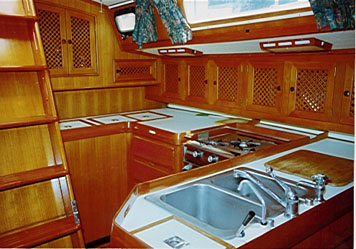
This galley is made for cookin'
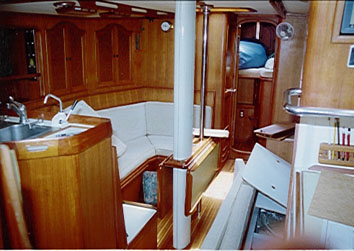
Salon is plenty spacious with more than adequate seating. However, the drop leaf table is very hard to get around. Like a movie theater, nobody wants to sit in the center.
Now, there is a second companionway hatch forward of the cockpit that heads down a very steep ladder into the galley/salon. But its in a most convenient location, right under the boom. I didn't understand this arrangement either. No one is going to use this owing to the inconvenience. So what you end up with is a long-timer in the head, blocking traffic to the main cabin. Hey! Come on and get the hell out of there so I can get a beer! While there is a forward head too, have no doubt about which one gets used the most.
Speaking of galley, take a look at it. Galley seems to be what this boat is all about. I mean is this a boat layed out for a gourmet or what? Aside from the extensive woodwork, the galley is THE most prominent feature. Its designed to be used. There are a lot of things I'd do differently here, but I'm going to leave this one alone because seeing such a nice galley simply made me hungry. If you are sick to death of sandwiches and mama (or you) can cook, you'll need to think about this one. Rare to find such a nice set up.
If this doesn't have you scratching your head, surely the forward cabin will wrinkle your brow. The two berths are situated at nearly shoulder height. I don't know about you, but if I had this kind of bucks, and at my age I rather quickly got tired of four people sleeping on converted seats, with a boat this size I want a nice sleeping cabin. Not one like a tree hut where you have to climb steps to get into a bed with 3' of head room, or one with the main traffic pattern going through it, but one that seals me off from the rest of the crowd. Its not until you stop and really look at it that you realize that the sleeping accommodations aren't much different than your old 30 footer.
Woodwork, yeah. Loads of it, and good stuff too. Not fine woodwork, but well beyond the run of the mill. If you are hard on a boat and not keen on keeping it up, better go look at one of those chlorox bottles with an all glass liner. Seventeen years old and there was hardly a scratch on it. But I got to tell you, the owner has to be one son-of-a-bitch to keep it up that way. Meaning he's going to keel haul any jerk going around with a screwdriver sticking out of his back pocket. Or some such. It also means that when you see a leak, you don't look the other way but repair it immediately. Nor do you sail with the hatches open. Keeping up an interior like this is not easy and has to be treated line fine furniture, which this one was. This is a boat for wood lovers, for sure.
About the hull, here we had a problem. Not a boat for purists, it is loaded with systems, A/C, generator, water maker, lots of tankage and other gizmos. So there wasn't much of the internal hull that was visible. However, one thing is clear. Each and every partition and cabinet divider is tabbed into the hull as a frame. There must be two dozen of them, making for a hull that is very well framed. Not slopped in there with chopped strand mat either, all the tabbing is multiple layers of 2 oz cloth, all nice and neat. Chain plates? Well, there's a shot of those that tell the story. Despite not being able to see much, it took me about ten minutes to figure that this is no squeeze bottle boat. There's not going to be a problem with the rigging always going loose because of a flimsy, bendy, twisty distorting hull.
Fit and finish is pretty much first class. I'll admit I tend to lose perspective a bit when I'm on one of those superyachts and am looking at some of the finest woodwork in the world. But this is pretty good for a production boat. Notice the arched salon cabinets with the latticed panels on the doors. And everything is pretty well rounded where it should be to minimize the real bad bruises. The available literature says this boat weights 28,000 lbs. but in looking at all that woodwork, I have a hard time believing that. Wood is heavy, and there's a lot of it.
Ambiance. You hang around boats long enough and you begin to detect that boats, like rooms in a house or office, have acoustic qualities. I notice it immediately on going aboard any boat. It can have a harsh, thin, tinny sound, like a boat with fiberglass liners, or it can have a hushed, very quite atmosphere inside. When you go down below in this one, the outer world disappears. It has that nice hushed quality that only a lot of wood and mass can give it. This yacht has that ambiance that is very rare to find in a sailing yacht this size. Unfortunately, the cabin sole foundation was not laid right and it squeaks everywhere you walk. See additional comments under Mistakes below.
Rigging. The mast is a rather smallish section, which caught my attention, but so did the heavy rigging with conventional double uppers and lowers with StaLoc fittings. No nonsense here at all. All first rate stuff with a good layout for your winching and sheet leads. I don't see anything to complain about here. Except in really heavy weather I'd be looking at the spar a lot.
Teak Decks. Nice, but . . . . However thick they were originally, they are now worn down to the screw heads. That's a problem that rarely, if ever, gets remedied because of the tremendous cost. It is at this point that nice yachts begin to go downhill in a hurry because now the appearance of the yacht is sullied more or less for the duration. The value drops and then people who can't really afford these yachts buy them. At which point the deck surely will not be replaced.
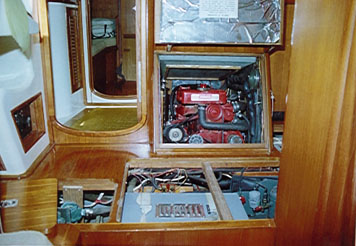
The lack of engine access can make one rather unhappy. Bilge spaces are fairly crammed with systems.
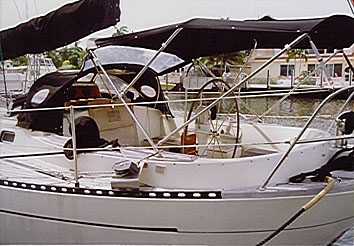
A cockpit with space for four at best, its narrow and cramped.
Systems. Ugh, this is not the way I'd do things. The engine is buried in a hole with very poor access. Awful, really. The generator in the lazarette is an add-on, or so I believe. The lazarette is accessed through a hatch behind the cockpit coaming. Since there are no seat lockers, stuff tends to get thrown down there. Problem is the steering gear is right there, and it piles up in opening, making it harder to reach the generator. Typical of most sail yachts, maintaining systems is about that last thing on the minds of designers. And it shows.
It was a major chore just to find where things were located. Beneath the cabin soles (see above photo) stuff is crammed into the bilge spaces with a shoe horn. Sure hope the owner can afford to pay someone else to do the maintenance because I wouldn't wish this on anybody. Cuss and bitch territory here. Bloody knuckles, too. On the other hand, the installations are as neat as they can be under the circumstances. At least there were no lame brains at work here.
Mistakes. The major one is that the stainless steel water tanks under the salon settee are sitting on the cabin sole. The framework of the settee is what holds them in place. Can you guess what has happened? Umm hmmm. The tanks are breaking the settee apart.
I don't know if the air conditioning is after market or not, but the way it is installed looks like it was built in. If added later, it must have been at enormous cost for there are none of those shoddy hack installations like I see with so many add-ons. Problem is, too many people don't know how to install A/C, and dealing with the huge amounts of condensation the CONDENSERS produce is it. As usual, in this case the forward cabin unit is leaking condensate and, because its one of those self contained units stowed away on a shelf behind some paneling, the paneling is rotting and ruined. Installing A/C requires knowledge and care, skills that were lacking in this case.
The cockpit. Quite small, I wonder why one designs a boat that sleeps 8 but the cockpit will not hold 6 and will be cramped for 4. Its laid out okay, but where you going to put the rest of the people? The 40" destroyer wheel is nice, except that it doesn't fit. Okay, so you don't mind climbing over the seats to get to the helm, but I do. In fact, just me alone in the cockpit was tight. Most people accept the universal design principle that sailboats should be as inconvenient as possible; that navigating the decks should be an obstacle course; that one should spend the better part of his days and nights climbing over and under things. Maybe this is the real reason people have abandoned sailing in droves. Maybe they're tired of designs that seem to go out their way to make you miserable, that work you hard and wear you down. Here we've got a beautifully unobstructed foredeck, and a cockpit so cramped and tight that . . . well, no fat people or linebackers allowed. Scaled to 5'6" and under, and I'm not sure about that.
Some people write me to say, "Well, Mr. Pascoe, if you're so smart, how you have done it better?" The answer to that is just like other designers have done it better. The cockpit was sacrificed for the full, stand up aft stateroom, an unsatisfactory tradeoff since good cockpit design should be primary, the place where good design is most important, the place where you are most often. The aft stateroom and head were botched by placing it in the main traffic pattern. I would have sacrificed head room there by moving the cockpit forward with the companionway direct to the galley, where the secondary one now exists, making the aft a secondary stateroom, while putting the master stateroom forward, eliminating the vee berth cabin and placing the forward head where the vee berth is now located. That cabin is worse than ridiculous. Then I would have created a large foc'sle for stowage rather than trying to store stuff on top of the steering gear. You'd lose a bit of salon space, but not much. And its already very large. Large settees look nice, but they mostly go unused because no one wants to sit in the middle. Center tables are a pain because they are always in the way. Get rid of it and have an L-shaped settee instead. How often are you going to want to seat 8-9 people in the salon? Six is enough, and you'll have more floor space to boot. At least the six will be able to move.
* * * * * * *Over the decades, I've watched a lot of high quality older yachts go into decline. And I've observed how and why it happens that such fine vessels meet their end. As yachts get older, the price drops while maintenance increases dramatically. Buyers come along who can afford the price, but not the cost of keeping it up. Insufficiently knowledgeable about what it takes to keep it maintained, they learn the hard way that it costs five times or more what they expected. They own the boat for a few years, can't afford to fix what needs fixing, and so it spirals downward until it becomes one of those back lot specials.
Aside from the decks, this boat is maintained in superb condition, but the decks are the beginning of the end. Few people really understand what maintenance hogs fine yachts can be. This yacht is no exception. With all that woodwork and complex systems crammed into tight spots with poor accessibility, you can expect the annual cost of ownership to run to 15% of value easily.
My review of this yacht leaves little doubt that the designer and builder were people who knew their stuff, at least as far as construction is concerned. Anyone who writes a check this large should know what they're doing, too. If you can handle the weird layout, you'd best be prepared for some serious management tasks.
I'm ignoring the strangeness of the layout in giving this rating since inconvenience is more or less a standard feature on most sail boats.
Posted August 1, 1998
 Visit davidpascoe.com for his power boat books
Visit davidpascoe.com for his power boat books 














David Pascoe is a second generation marine surveyor in his family who began his surveying career at age 16 as an apprentice in 1965 as the era of wooden boats was drawing to a close.
Certified by the National Association of Marine Surveyors in 1972, he has conducted over 5,000 pre purchase surveys in addition to having conducted hundreds of boating accident investigations, including fires, sinkings, hull failures and machinery failure analysis.
Over forty years of knowledge and experience are brought to bear in following books. David Pascoe is the author of:
In addition to readers in the United States, boaters and boat industry professionals worldwide from nearly 80 countries have purchased David Pascoe's books, since introduction of his first book in 2001.
In 2012, David Pascoe has retired from marine surveying business at age 65.
On November 23rd, 2018, David Pascoe has passed away at age 71.
Biography - Long version